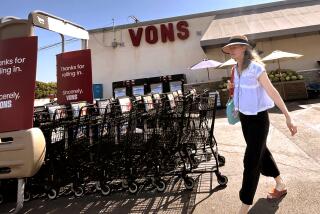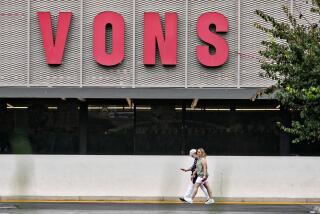South L.A. Still Awaiting Promised Grocery Stores
Only about half of the full-service grocery stores promised for a riot-torn stretch of Los Angeles and other low-income communities in the South Los Angeles region were built, a study to be released today found.
After the 1992 unrest, executives with Vons Cos., Ralphs Grocery Co., Food 4 Less and Smart & Final Inc. vowed to build as many as 32 new supermarkets in the central city and nearby low-income areas with limited access to fresh meats and produce, according to the report by the Urban and Environmental Policy Institute at Occidental College.
But, according to the report and the grocery chains, only 18 chain stores opened in the last 10 years in or near the South L.A. area initially targeted by RLA, the nonprofit group set up after the riots to help rejuvenate the area. And several of those replaced existing company stores and did not increase overall access to quality food marts in the area.
RLA, formerly known as Rebuild L.A., pushed supermarket construction as one means to address crucial needs in the region.
But the chains pulled back on building stores, and nationwide consolidation in the grocery industry in the 1990s was sweeping from the landscape some chains that had been prominent in the area.
From 1992 to 2002, the number of chain stores in the area of South Los Angeles hardest hit by the riots grew by only seven, according to the report. Even with independents opening markets--especially stores aimed at Latino clients--shopping options in South Los Angeles continue to lag behind other regions, according to the study.
“This shows the lack of access [to] full-service supermarkets, and that hasn’t really changed since 1992, even though there was significant rhetoric and promises,” said Robert Gottlieb, a professor of urban and environmental policy at Occidental, who worked with Amanda Schaffer, a student who compiled the data, to produce the study.
“Certainly promises were made, but most of those promises were not kept.”
The chain that “made the biggest commitment and did the least,” said Los Angeles City Councilman Mark Ridley-Thomas, was Vons.
In a well-publicized news conference in July 1992, Roger Stangeland, then-chairman of Vons, announced a $100-million plan to build 12 or more grocery stores in inner-city Los Angeles and surrounding communities. Then-RLA Chairman Peter V. Ueberroth praised the chain for setting a good example for other companies.
RLA had focused attention on the grocery needs in a 52-square-mile stretch from Wilshire to El Segundo boulevards and Alameda Street to Crenshaw Boulevard. And it was widely anticipated that the new stores would be built in or near that area.
Sandra Calderon, a spokeswoman for Vons, now a unit of Safeway Inc., said the $100-million commitment was not just to build stores in South L.A. but also to rebuild some existing stores and provide employee training.
As part of the commitment, Vons opened one store within the RLA target area, on Compton Boulevard in Compton, and a store in a low-income area of Pomona. The Pomona and Compton stores have since closed.
In the last 10 years, the company also abandoned plans to build at Slauson and Vermont avenues and to upgrade a store in the Pico-Union area.
“Each [decision] had its own reasons, but basically the issue was economics,” said Calderon, adding that the shuttered Compton store operated at a loss for years, even after it was converted to a warehouse format.
“Independents are able to run their stores at more competitive prices. We pay union rates,” she said, adding that the average Vons clerk earns about $18 an hour.
Among the most active and successful retailers in the region are Smart & Final and Food 4 Less, two chains that appeal to discount shoppers.
Commerce-based Smart & Final committed to opening 12 stores in the region, according to the report, and opened at least seven outlets in or near the target area. One replaced a Vermont Avenue store burned down in the unrest.
Food 4 Less announced plans to build as many as four stores and opened eight, including some that replaced their corporate cousins, such as Boys and Viva. In the last 10 years, mergers and consolidations combined Ralphs, Boys, Viva, Food 4 Less and other chains under the umbrella of Kroger Co., the largest U.S. supermarket operator.
Ralphs committed to four stores and built two. Today, two-thirds of the stores in the region are either Ralphs or Food 4 Less, according to the report.
Ridley-Thomas, whose 8th Council District was hit hard by the riots, concedes that the region remains underserved. But he was nonetheless pleased with the progress made thus far.
“You have more stores, and you have better-built stores,” he said. “There’s a lot to celebrate, but the grocery bag is only half full.”
More to Read
Inside the business of entertainment
The Wide Shot brings you news, analysis and insights on everything from streaming wars to production — and what it all means for the future.
You may occasionally receive promotional content from the Los Angeles Times.










